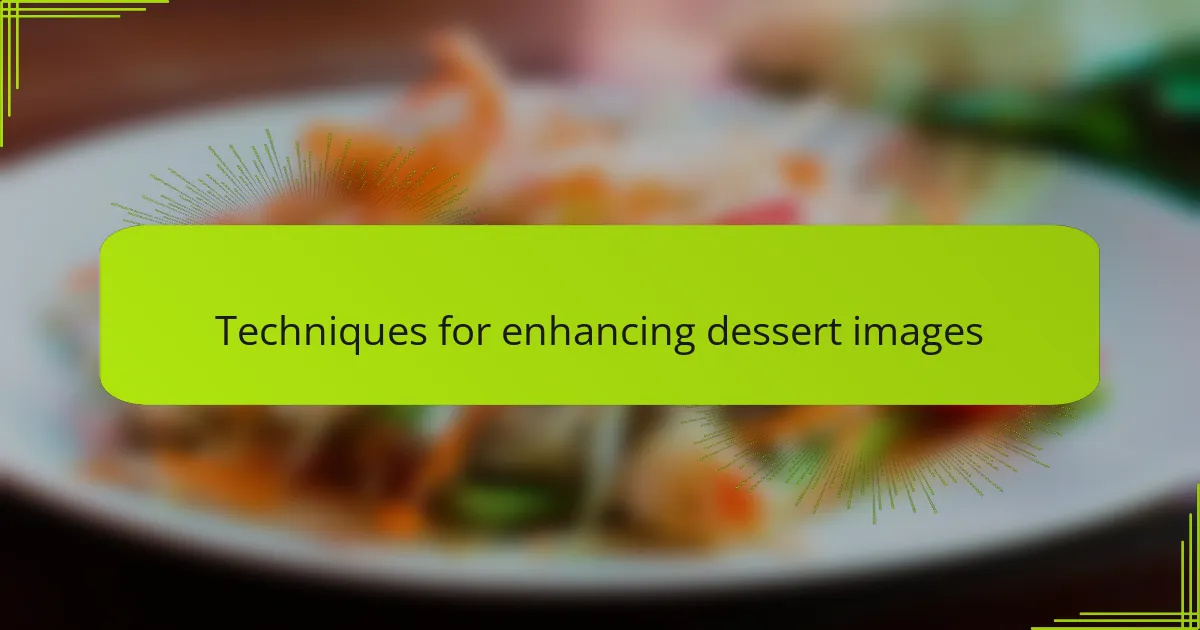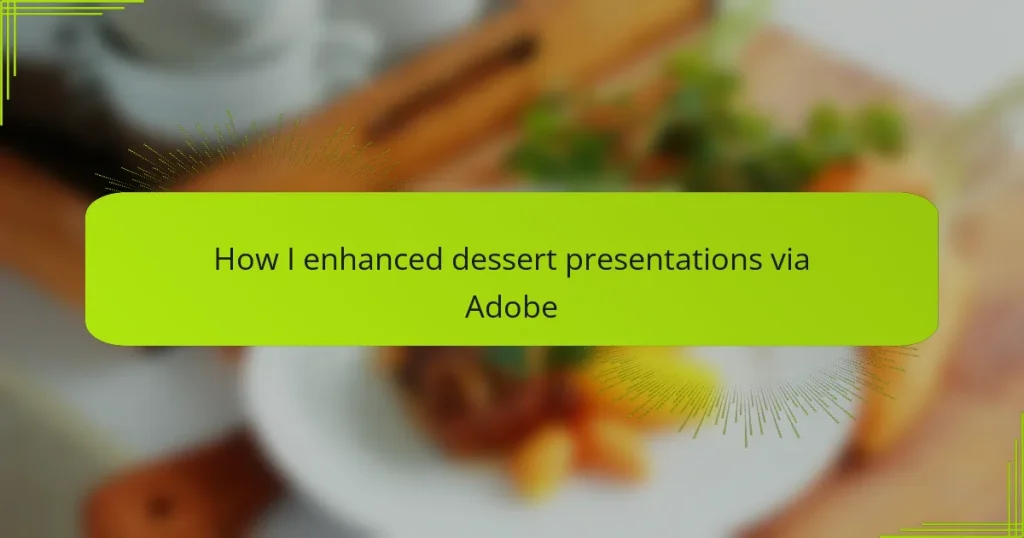Key takeaways
- Dessert recipes evoke memories and creativity, emphasizing the importance of flavor and presentation.
- Presentation enhances anticipation; balancing colors, shapes, and textures can elevate even simple desserts.
- Adobe tools like Photoshop and Illustrator can significantly improve dessert photography by enhancing colors, textures, and overall appeal.
- Technique and restraint in editing are crucial for creating authentic, enticing dessert images that invite tasting.

Introduction to dessert recipes
Dessert recipes have always held a special place in my kitchen—not just for the sweet flavors but for the memories they evoke. Have you ever noticed how a simple slice of cake or a bowl of pudding can instantly brighten your day? That’s the magic behind crafting desserts that go beyond taste to create moments of joy.
When I first started experimenting with dessert recipes, I realized there’s so much more than just following steps. It’s about understanding each ingredient’s role and how the presentation can enhance the overall experience. Don’t you think the way a dessert looks can be just as tempting as the way it tastes?
Over time, I learned that dessert recipes are like a canvas waiting to come alive. Each recipe offers endless possibilities to express creativity and delight the senses. Isn’t it exciting to discover new ways to transform familiar sweets into unforgettable treats?

Basics of dessert presentation
Presentation is the first taste we get of a dessert, even before the fork touches our lips. I’ve noticed that a well-plated dessert instantly builds anticipation, almost like setting the stage for the flavors to shine. Have you ever hesitated to try something simply because it looked messy? That’s how crucial presentation truly is.
For me, balancing colors, shapes, and textures is key. A sprinkle of fresh mint or a drizzle of sauce can turn a humble dessert into a feast for the eyes. When I started paying attention to these small details, my creations didn’t just taste better—they felt more special.
Sometimes, simplicity works best. I’ve found that even a clean, minimalistic plating can make a rich chocolate mousse or a vibrant fruit tart stand out. Don’t you think that restraint in presentation can enhance the excitement of every bite?

Overview of Adobe tools for food styling
Adobe offers an impressive suite of tools that can truly elevate how we style and showcase desserts. I found that Photoshop, with its powerful editing features, lets me adjust lighting and colors to make every detail pop, almost like bringing my dessert to life on screen. Have you ever taken a photo and noticed how just a slight tweak can make the chocolate glaze look irresistible?
Illustrator plays a different but equally fascinating role. I enjoy creating custom graphics or overlays to frame my dessert photos, which adds a unique touch and highlights the treat’s personality. It’s like adding a sprinkle of creativity on top of the actual dessert presentation.
When I combine these Adobe tools, the effect is much more than digital enhancement—it becomes a collaborative art between the dish and the design. Isn’t it intriguing how technology can deepen our appreciation for food styling and inspire new ways to tempt the eyes before the palate?

Techniques for enhancing dessert images
One trick I swear by is using Photoshop’s selective color adjustments. It’s amazing how slightly enhancing the reds or warm tones makes strawberries and cherries pop right off the screen. Have you ever noticed how a simple color tweak can suddenly make your dessert look fresher and more tempting?
Another technique I lean on is sharpening details around the edges of the dessert. Sometimes, the frosting or fruit textures get a little lost in photos, but a subtle clarity boost brings those elements back into focus. It’s like giving your dessert a spotlight—don’t you think that makes the difference between a good photo and one that makes you crave a bite?
Finally, I love adding soft shadows or highlights to create depth. Instead of a flat image, the dessert seems to have dimension and life. When I see that extra layer of realism, it reminds me why we eat first with our eyes. Can you imagine how much more inviting your sweet creations become with just a touch of thoughtful lighting enhancement?

Step-by-step guide to using Adobe
Getting started with Adobe felt a bit overwhelming at first, but breaking it down into clear steps really helped me gain confidence. I usually begin by importing my dessert photos into Photoshop, where cropping and adjusting the exposure set the foundation. Have you ever noticed how a simple crop can completely change the focus and mood of an image?
Next, I dive into fine-tuning colors and textures with adjustment layers—this part feels like bringing my dessert back to the way it looked in real life, or even better. Sometimes I play around with filters to add subtle effects, but I always remind myself to keep the look natural, because authenticity matters in food styling.
Lastly, when I want to get creative, I switch over to Illustrator to design custom elements like frames or typography that complement the photo. Combining these steps builds a polished presentation that truly reflects my dessert’s charm. Have you tried layering digital touches that still let the dessert itself shine? It’s a balancing act, but the results are so rewarding.

My experience improving dessert photos
Improving my dessert photos has been a game-changer in sharing my creations with others. I remember the first time I edited a simple cupcake photo—adjusting the lighting and colors in Photoshop made it look almost good enough to eat right off the screen. Have you ever been surprised by how much a little editing can turn an average shot into something truly mouthwatering?
Sometimes, I get lost in the little details, like sharpening the texture of frosting or enhancing the gloss on a chocolate drizzle. It’s incredible how these small tweaks breathe life back into photos that initially felt flat or dull. For me, each edit is like giving my desserts a second chance to impress, even before anyone tastes them.
One moment that sticks with me is when I added a soft shadow beneath a fruit tart photo—suddenly, it felt three-dimensional and inviting. Isn’t it fascinating how playing with depth can awaken our senses and make a viewer almost reach through the screen for a bite? These experiences taught me that improving dessert photos isn’t just about technique—it’s about creating a visual story that draws people in.

Tips for applying Adobe skills to desserts
When applying Adobe skills to dessert presentations, I’ve found that layering textures in Photoshop can really bring out the lusciousness of a cake’s frosting or the delicate crunch of a caramelized top. Have you ever noticed how textures jump off the screen when given the right digital treatment? It’s like adding an invisible sprinkle of magic that makes viewers crave the dessert before even tasting it.
Sometimes, I play with subtle vignettes or framing effects in Illustrator to direct the eye exactly where I want it—usually straight to the star of the plate. This kind of digital styling feels like setting the perfect spotlight in a theater, giving my desserts a stage to shine on. Isn’t it amazing how a simple frame or graphic element can elevate a photo from casual to captivating?
Moreover, I always remind myself not to overdo it. Adobe tools are powerful, but the goal is to enhance rather than overshadow the real beauty of the dessert. Does a beautifully plated tart really need a flashy filter? For me, restraint in editing keeps the dessert feeling authentic and inviting, just like I want my guests to experience it in person.




